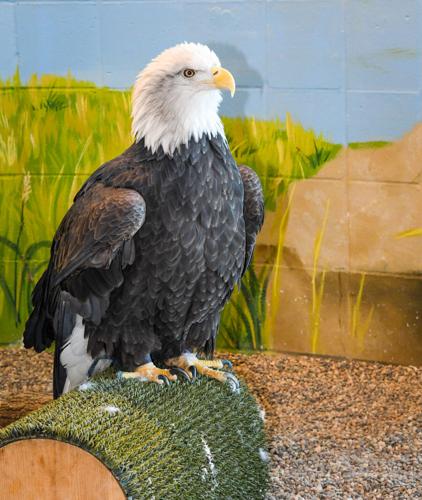Looking from the standpoint of a wildlife photographer, the current wave of warm weather does not aid getting images of bald eagles.
Ideal eagle capture conditions include below-freezing temps and long stretches of iced-over river.
When vast areas of river are locked in ice, eagles are concentrated in the few open water areas. The best of these feature shallow bars where the king-sized raptors can effectively see and catch fish.
A couple Saturdays ago, with cabin fever pulling at us, Katie and I headed to scenic Wabasha to observe and photograph eagles. As always, we did not forget to stop at the National Eagle Center, located on the banks of the Mississippi, right in the heart of downtown Wabasha.
It is always a pleasure to peruse the center and watch the live eagles they use for education. The eagles that live at the center are rehabilitated birds who have suffered injuries that prevent them from being released back into their native habitat.
Our visit was a bit different this time as the center’s protocols have changed with the COVID-19 pandemic. Normally, visitors can just stroll into the center during business hours. This year, we had to sign up on-line and register for a certain block of time.
Fortunately, I checked out their website for that very thing the previous evening. When we arrived at our allotted time, several other parties had to be turned away because they had no reservations.
对于任何wishing to visit the Eagle Center, make sure to go through the registration process on their website at least a day in advance.
第一次由码头游客经常吓了一跳cing shrieks emanated by the resident birds when other eagles wing by over the river just outside the center’s large glass windows. Once a passing bird disappears from view, the eagles become quiet, but their heads remain on a swivel looking at everything in their wide arc of view.
In a normal year, there are ongoing seminars that detail all aspects of eagle behaviors. As of now, those gatherings are closed off, but any of the staff are more than willing to answer any questions from attendees.
When the seminars were active, the most queried question was on the resurgence of eagles over the last 30 years. Among other things, it was the banning of the pesticide DDT in 1972 that eventually led to a comeback of our national symbol.
DDT chemicals found their way, via run-off into waterways, and then into fish, which were consumed by eagles. The chemical also thinned eagle eggshells, leading to skyrocketing mortality among pre-hatched chicks.
The subsequent eagle comeback has jumped exponentially, and it is not uncommon to see eagles soaring over the Mankato river valley nearly every day, especially in winter when the birds congregate near preferred feeding areas.
After leaving the Eagle Center, we drove a few miles north where a few dozen eagles were fishing on an unfrozen stretch of river. Most of the birds stayed far from camera range, too far for the 500mm lens I had brought but in great position for one photographer who had a gargantuan 800mm lens sitting atop a stout tripod pointed at the careening birds.
The eagles were interested in a large raft of goldeneye diver ducks fishing on the same stretch of river. The scene was comical, proving that even majestic birds like eagles don’t always learn from mistakes.
Over and over, eagles would swoop down, talons outstretched in effort to snatch a duck. But, every time, the small, fast ducks would disappear under the water with quick dives only to reappear seconds later to repeat the scenario.
In the hour we watched, not one duck ended up in an eagle’s grasp. Eagles are sometimes successful at procuring duck dinners, but those are usually puddle ducks like teal with meager diving instincts.
I did locate one willing eagle who perched in a cottonwood along the river’s edge. The mature, white-headed bird let me get close as he gazed at the shallow water in search of fish prey. I caught a few images as he returned to a wispy perch after his own futile try at duck hunting.
The river section was full of birds perched on the opposite bank. I heard one bird watcher remark about the number of golden eagles in the trees. Another serious birder let him know those were in fact, immature bald eagles who had not aged to 3 years old when they begin get their signature white heads.
There are a few golden eagles in the Mississippi river valley, but they are highfliers who search out prey from towering heights and do not generally congregate with their bald eagle cousins. They also tend to prefer wide open, grassland habitat to hunt.
To differentiate the birds, note that golden eagles have feathering that descends down to their feet, while bald eagles’ yellow ankles are bare. Finally, goldens sport a gold mass of head feathers lighter than an immature bald eagles’ head feathering.
Satisfied with our cabin fever excursion, we headed west, back to Kato. This eagle trip had ended, but it only spurred me to plan another in South Dakota to capture goldens hunting in their prairie habitat.
Mark Morrison is an avid hunter and fisherman who has been a freelance outdoors writer and photographer for more than 20 years. The Mankato resident since 1979 may be contacted atmercuryphotog@aol.com.




























Commented
Sorry, there are no recent results for popular commented articles.